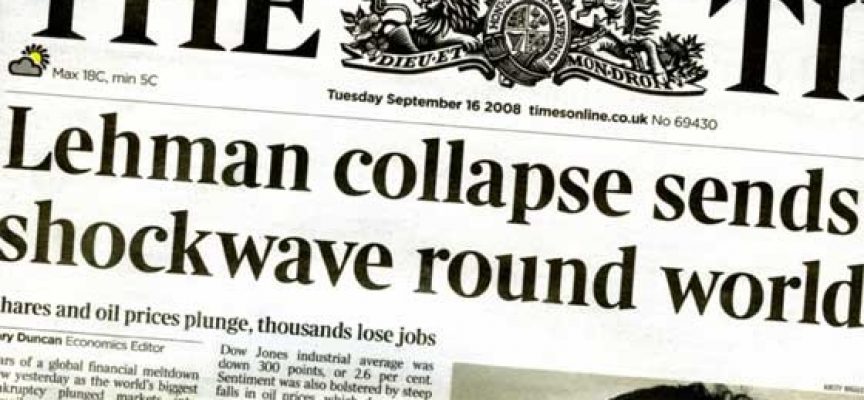A terrifying Lehman-style banking crisis is about to be unleashed.
July 28 (King World News) – Alasdair Macleod: It is increasingly clear that the euro system is in deep trouble, caught out by the surge in consumer price inflation. Rising interest rates, which have only just started, will undermine Eurozone commercial bank balance sheets because they obtain much of their liquidity by borrowing through the repo market.TARGET2 imbalances threaten to collapse the system from within as the interest rate environment changes. The ECB and its shareholding network of national central banks all face escalating losses on their bonds, which earlier this month I calculated to be in the region of €750bn, nearly seven times the combined euro system balance sheet equity.
Not only does the whole euro system require to be refinanced, but this is at a time when the Eurozone’s G-SIBs are even more highly leveraged than the three British ones. Table 2 updates the one in my article referred to above.
With the average Eurozone G-SIB asset to equity ratios of over 20 times, the euro’s G-SIBs are one of the two most highly leveraged networks in global banking, the other being Japan’s. The common factor is negative interest rates imposed by their central banks. The consequence has been to squeeze credit margins to the extent that the only way in which banks can sustain profit levels is to increase operational gearing. Furthermore, an average balance sheet leverage of over 20 times does not properly identify systemic risks. Bank problems come from extremes, and we can see that at 27 times, Group Credit Agricole should concern us most in this list. And we don’t see all the other Eurozone banks trading internationally that don’t make the G-SIB list, some of which are likely to be similarly exposed.
… Counterparty failures will contaminate systemically all participants, not only dealing in euros but all the other major currencies settled in London as well. The damage is sure to extend to forex and credit markets, including all OTC derivatives which are an integral part of bank clearing facilities.
At the last turn of the bank lending cycle, it was the securitisation of liar loans in the US which led to what is commonly referred to as the Great Financial Crisis. This is a term I have rarely used, preferring to call it the Lehman Crisis because I knew, along with many others, that the non-resolution of the excesses at the time would store up for an even greater crisis in the future. We can now begin see how it will be manifested. And this time, it looks like being centred on London as a financial centre rather than New York.
We must hope that a collapse of the euro system will not happen, but there is mounting evidence that it will indeed occur. The falling row of dominoes is pointing at London, and it could even happen before the Conservative Party membership have voted for either Truss or Sunak in early-September.
Dealing with a banking crisis fall out
On the advice of the Bank for International Settlements, following the Lehman crisis the G20 member states agreed to make bail-ins mandatory, replacing bailouts. This was a politically motivated move, fuelled by the emotive belief that bailing out banks are at the taxpayers’ expense. In fact, bank bailouts are financed by central banks, both directly and indirectly. The only taxpayer involvement is marginally through their aggregated savings in pension funds and insurance companies. But these funds have been over-compensated with extra cash through quantitative easing. The audit trail leads to the expansion of currency and credit every time, and not to taxes as the phrase “taxpayer liabilities” implies.
All the G20 nations have passed legislation enabling bail-in procedures. In the Bank of England’s case, it retains discretion to what extent bail-in as opposed to other rescue methods might be used. As to specifics for the other G20 members it is unclear to what extent they have retained this flexibility and understand bail-in ramifications. And it could be an additional confusion likely to complicate a global banking rescue, compared with the previously accepted bail-out procedures.
In theory, a bail-in reallocates a bank’s liabilities from deposits and loans into shareholders’ capital — excepting, perhaps, smaller depositors covered by deposit guarantee schemes. But even that is at the authorities’ discretion.
The objective can only make sense for single bank, as opposed to systemic failures. But if it were to be applied to an individual banking failure in the current unstable situation, it would almost certainly undermine other banks, as bank loans and other non-equity interests would be generally liquidated, and deposits flee to banks deemed to be safer as panic sets in. The risk is that bail-in procedures could set off a system-wide failure, particularly of the banks rated by the market with substantial discounts to book value.
Even assuming the Bank’s bail-in procedures are ruled out in dealing with a systemic banking crisis, to keep banks operating will require a massive expansion of credit from the Bank of England. In effect, the central bank will end up taking on the entire banking system’s obligations. With London at the centre of a global banking crisis, all other major central banks whose banking and currency networks are exposed to it must be prepared to take on all their commercial banking obligations as well.
… The task is not impossible. Currencies have completely collapsed before, and nations survived. Instead of being restricted to one or a group of nations, the looming crisis threatens to take out what we used to call the advanced economies in their entirety, so it will be a bigger deal. Fortunately for Britain, her citizens are less likely to riot than their continental cousins. But as a warm-up for the main event, our new leader will have to navigate through growing discontent brought on by rising prices, labour strikes and all the other forms of economic pestilence which bought Margaret Thatcher to power.
ALSO RELEASED: Solid Gold, Who Will Pay The Electric Bill? And Fed Preparing CLICK HERE.
ALSO RELEASED: Stocks And Gold Rally As Fed Hikes But Look At These Two Stunning Charts CLICK HERE.
ALSO RELEASED: JP Morgan Traders Rig The Gold Market While Gold Derivatives Explode CLICK HERE.
ALSO RELEASED: Greyerz Warns U.S. Has A Huge Problem, Plus A Stunning Big Picture Look At Silver CLICK HERE.
ALSO RELEASED: CONTRARIAN ALERT: Traders Bet Gold And Miners Will Continue Historic Plunge CLICK HERE.
ALSO RELEASED: Putin Has Russia Booming But The West Is In Serious Trouble And China Is Doing A Major Pivot CLICK HERE.
ALSO RELEASED: Central Planners Can’t Hold Down The Price Of Gold Much Longer CLICK HERE.
ALSO RELEASED: Bullion Banks Massive Short Covering In Gold & Silver Markets CLICK HERE.
***To listen to Gerald Celente discuss why the price of gold today should be $2,500 and silver $70-$100 as well as what surprises to expect in the back half of this year CLICK HERE OR ON THE IMAGE BELOW.
© 2022 by King World News®. All Rights Reserved. This material may not be published, broadcast, rewritten, or redistributed. However, linking directly to the articles is permitted and encouraged.









